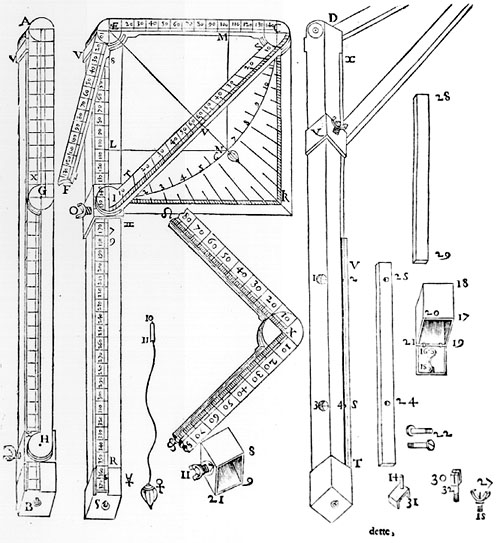 Description
Description
AB: a board, about 72-cm-long (in box-wood or
ebony, whose square section's side is 13 mm long. AG and GH are
two metallic rules. Th AG e rule is hinged
at A to a board and at G to a rule (GH), which is hinged
to a square section's ring (H).
At the centre of the page the instrument is shown: ES is the board, FIC is
the Balestrino, forming a right angle IEC; the ring IO is
blocked in its place by means of a screw (O), EF is the other
leg.
Both the square's parts CE and EF and the leg ES are
divided into tens each divided again into ten degrees. The tens' length
is as long as the length of the radius of the circle where the rules' heads
are embedded together, as is shown in X.
The diagonal CI is
used as a quadrant.
In order to show the degrees on it, a quarter of the
circle whose radius is the same as EC must
be drawn on a sheet of paper, and it must be divided into 120 degrees,
60 per each part. By leaning the instrument on the drawing, divisions are
drawn
on the diagonal: in this way, the sixth degree from the two sides starting
from the centre N is obtained. This is used by bombers to focus
the artillery at the elevation required to hit the target; the elevation
on the
diagonal CI can be read with the aid of a plumb-line, blocked into E.
Onto the back part of the two rules (ECI) two lines are drawn with
the balls' diameters and respective weights. Another line is drawn along
a rule and its distance from the first line will be useful to know the
wind required per each ball. The diameter of a one-pound ball is drawn
on it as
well. By measuring this distance with a compass, the square ring is moved
along the ES leg until the oblique distance between the two points
shown on the two lines is found, then it is blocked at the right point
by the screw O. After that, the instrument will show all the balls'
weights and winds.